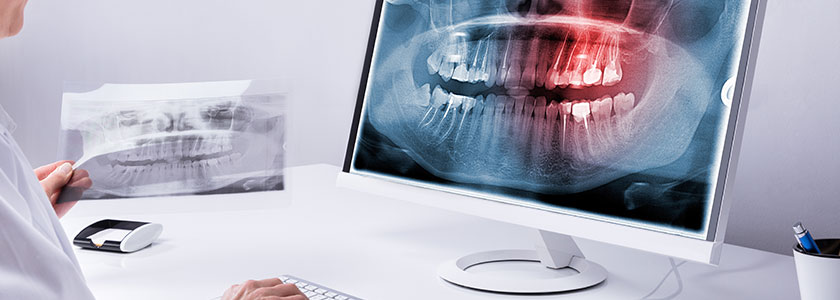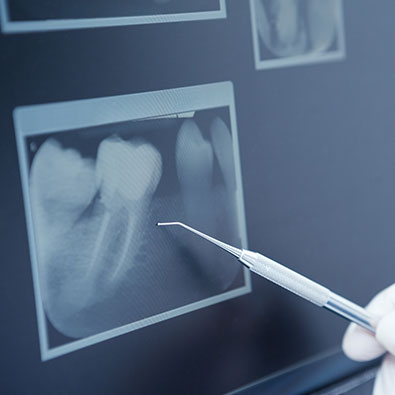- 9977 178 St NW Unit 1 Edmonton AB T5T 6J6 CA
Are dental X-rays safe? How often should dental X-rays be taken? Find out below from Today's Dental in Edmonton.

Digital radiography (digital x-ray) is technology used to take dental x-rays.
This technique uses an electronic sensor (instead of x-ray film) that captures and stores the digital image on a computer.
This image can be instantly viewed and enlarged helping the dentist and dental hygienist detect problems easier. Digital x-rays reduce radiation 80-90% compared to the already low exposure of traditional dental x-rays.
Dental x-rays are essential, preventative, diagnostic tools that provide valuable information not visible during a regular dental exam.
Dentists and dental hygienists use this information to safely and accurately detect hidden dental abnormalities and complete an accurate treatment plan. Without x-rays, problem areas may go undetected.
Dental x-rays may reveal:
Panoramic X-rays (also known as Panorex® or orthopantomograms) are wraparound photographs of the face and teeth. They offer a view that would otherwise be invisible to the naked eye. X-rays in general, expose hidden structures, such as wisdom teeth, reveal preliminary signs of cavities, and show fractures and bone loss.
Panoramic X-rays are extraoral and simple to perform. Usually, dental X-rays involve the film being placed inside the mouth, but panoramic film is hidden inside a mechanism that rotates around the outside of the head.
Unlike bitewing X-rays that need to be taken every few years, panoramic X-rays are generally only taken on an as-needed basis. A panoramic x-ray is not conducted to give a detailed view of each tooth, but rather to provide a better view of the sinus areas, nasal areas and mandibular nerve. Panoramic X-rays are preferable to bitewing X-rays when a patient is in extreme pain, and when a sinus problem is suspected to have caused dental problems.
Panoramic X-rays are extremely versatile in dentistry, and are used to:
The panoramic X-ray provides the dentist with an ear-to-ear two-dimensional view of both the upper and lower jaw. The most common uses for panoramic X-rays are to reveal the positioning of wisdom teeth and to check whether dental implants will affect the mandibular nerve (the nerve extending toward the lower lip).
The Panorex equipment consists of a rotating arm that holds the X-ray generator, and a moving film attachment that holds the pictures. The head is positioned between these two devices. The X-ray generator moves around the head taking pictures as orthogonally as possible. The positioning of the head and body is what determines how sharp, clear and useful the X-rays will be to the dentist. The pictures are magnified by as much as 30% to ensure that even the minutest detail will be noted.
Panoramic X-rays are an important diagnostic tool and are also valuable for planning future treatment. They are safer than other types of X-ray because less radiation enters the body.
We are all exposed to natural radiation in our environment. Digital x-rays produce a significantly lower level of radiation compared to traditional dental x-rays.
Not only are digital x-rays better for the health and safety of the patient, they are faster and more comfortable to take, which reduces your time in the dental office.
Also, since the digital image is captured electronically, there is no need to develop the x-rays, thus eliminating the disposal of harmful waste and chemicals into the environment.
Even though digital x-rays produce a low level of radiation and are considered very safe, dentists still take necessary precautions to limit the patient’s exposure to radiation.
These precautions include only taking those x-rays that are necessary and using lead apron shields to protect the body.
How Often Should Dental X-rays Be Taken?The need for dental x-rays depends on each patient’s individual dental health needs. Your dentist and dental hygienist will recommend necessary x-rays based upon the review of your medical and dental history, a dental exam, signs and symptoms, your age, and risk of disease. A full mouth series of dental x-rays is recommended for new patients. A full series is usually good for three to five years. Bite-wing x-rays (x-rays of top and bottom teeth biting together) are taken at recall (check-up) visits and are recommended once or twice a year to detect new dental problems. |
 |